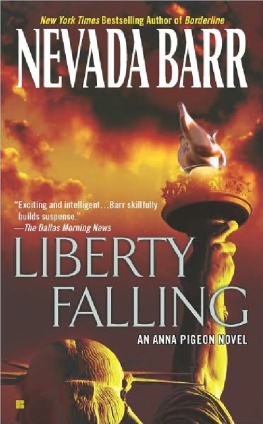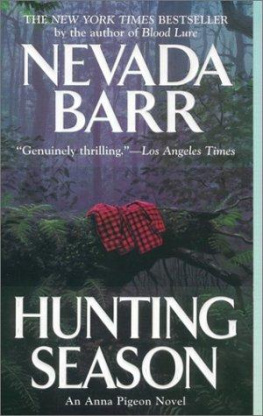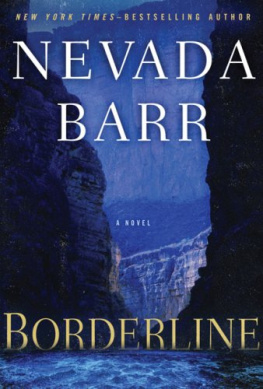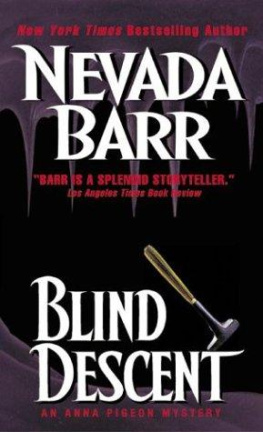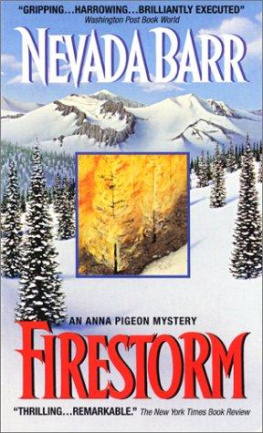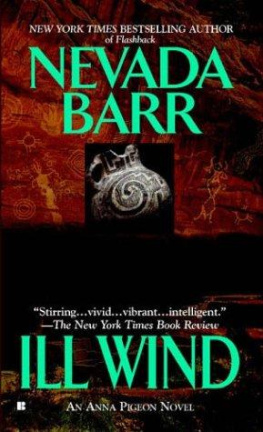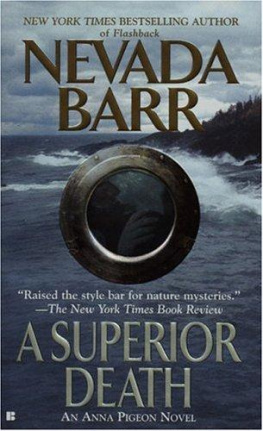Nevada Barr - Anna Pigeon 07 Liberty Falling
Here you can read online Nevada Barr - Anna Pigeon 07 Liberty Falling full text of the book (entire story) in english for free. Download pdf and epub, get meaning, cover and reviews about this ebook. year: 2010, publisher: Avon, genre: Science fiction. Description of the work, (preface) as well as reviews are available. Best literature library LitArk.com created for fans of good reading and offers a wide selection of genres:
Romance novel
Science fiction
Adventure
Detective
Science
History
Home and family
Prose
Art
Politics
Computer
Non-fiction
Religion
Business
Children
Humor
Choose a favorite category and find really read worthwhile books. Enjoy immersion in the world of imagination, feel the emotions of the characters or learn something new for yourself, make an fascinating discovery.
- Book:Anna Pigeon 07 Liberty Falling
- Author:
- Publisher:Avon
- Genre:
- Year:2010
- Rating:5 / 5
- Favourites:Add to favourites
- Your mark:
- 100
- 1
- 2
- 3
- 4
- 5
Anna Pigeon 07 Liberty Falling: summary, description and annotation
We offer to read an annotation, description, summary or preface (depends on what the author of the book "Anna Pigeon 07 Liberty Falling" wrote himself). If you haven't found the necessary information about the book — write in the comments, we will try to find it.
Anna Pigeon 07 Liberty Falling — read online for free the complete book (whole text) full work
Below is the text of the book, divided by pages. System saving the place of the last page read, allows you to conveniently read the book "Anna Pigeon 07 Liberty Falling" online for free, without having to search again every time where you left off. Put a bookmark, and you can go to the page where you finished reading at any time.
Font size:
Interval:
Bookmark:
LIBERTY
Falling
NEVADA BARR
For help on this book, I thank the staff of the Ellis Island and Statue of Liberty National Monuments; the Park Police on Ellis and Liberty (and yes, they are all handsome); the staff boat captains, and especially Becky Brock, who gave me the place and a bed to sleep in while I did my research; an individual who is too shy to be named; and Charlie DeLeo, who kindly let me use him in the story. And thanks to Fred Shirley for his time and expertise.
Since the writing of this book, plans have been made to stabilize the buildings on Islands II and III, though no work has yet begun. It is hoped that if the structures can be saved, there will be funds to restore them. Contributions toward this future restoration can be made to The Statue of Liberty Ellis Island Foundation; e-mail:
["mailto:pr@ellisisland.org"]pr@ellisisland.org.
FOR T R I S H: once my agent, twice my editor, always my friend
Of course Molly would live; anything else was unthinkable. But Anna was thinking it.
Concerned for her mental health--or their own--the nurses at Columbia-Presbyterian had banded together and banished Anna from the hospital for twelve hours. Once pried free of the rain-streaked monolith housing umpteen floors of misery, Anna fled the far reaches of the Upper West Side, spiraling down into the subway with the rainwater. Huddled on the Number 1 train, she rattled through the entrails of Manhattan to the end of the line: South Ferry. The subways weren't those she'd known as a young woman--a wife--living in New York City with Zach. These were clean, silver. They smelled of metal and electricity, like bumper cars at the carnival. Graffiti artists, frustrated by the glossy unpaintable surfaces, made futile attempts to etch gang symbols and lewd declarations of adolescent angst in the plastic of the windows. Vandals lacked patience and dedication.
At South Kerry, Anna sprinted up the stairs and burst from the station like a deadline-crazed commuter and across the three lanes of traffic that separated the subway from the pier. The National Park Service staff boat, the Liberty IV, was waiting at the Coast Guard clock, floating on the tip of Manhattan Island. Anna got aboard before they cast off. Kevin, the boat captain, winked. "I wouldn't have left you." She knew that, but she'd needed to run, to see the planks of the pier passing beneath her feet, to feel she'd outpaced the demons, beaten them to the boat. Ghosts can't cross open water.
On shipboard, she kept running. Avoiding kindly questions from Kevin, she left the warmth of the cabin and went to the stern. Under the dispirited flapping of the American flag, she watched the skyline, dominated by the twin towers of the World Trade Center, recede, carried away on the wake of the Liberty IV. Patsy Silva, the woman on Liberty Island with whom Anna was staying, referred to this pose, this view, as her "Barbra Streisand moment." It was the East Coast equivalent of Mary Tyler Moore throwing her hat into the air in downtown Minneapolis.
Crossing the harbor, Anna tried to fix her mind on the movie that had burned that image into the collective unconscious of a generation of theatergoers, but could not remember even the title.
The NPS boat stopped first at Ellis Island. From there it would continue its endless triangle, ferrying staff to Liberty Island, then the third leg of the run, back to MIO, the dock shared with the Marine Inspection Office of the U.S. Coast Guard where Anna had boarded. Farther out in the harbor, the Circle Line ferried its tourist cargo in roughly the same path but docking at different points on the islands. Anna was bunking in Patsy Silva's spare room in a cozy little cottage on Liberty Island in the shadow of the great lady herself. The view from Anna's bedroom--could it be duplicated--would jack the price of a condo into the high six figures. As it was park housing, Patsy and her roommate paid the staggering sum of one hundred and forty dollars a month; recompense for living in an area a GS-7 on NPS wages couldn't possibly afford.
Loath to go "home" immediately, to strand herself amid the all too human accoutrements of coffee cups and telephones, Anna thanked Kevin, disembarked at Ellis, the Liberty IV's first stop, and slunk away, keeping to deserted brick alleys.
For ease of reference, Ellis was divided into three "islands," though all three of its building complexes shared the same bit of earth and were joined together by a long windowed walkway. Island I was the facility the tourists saw. Spectacularly refurbished in 1986, it housed the museum, the Registry Hall, the baggage room and the service areas through which twelve million of the immigrants who poured into America from 1892 to 1954 had passed. Vaulted ceilings, as airy as those of a cathedral built to worship industry, intricate windows, modern baths, electricity, running water--all the state-of-the-art nineteenth-century architecture--had been lovingly restored to its original grandeur. And returned, Anna had little doubt, to its original cacophony. At Ellis's peak, ten thousand souls a clay were shepherded through the "golden door" to America.
Now Ellis, in season, saw eight to ten thousand visitors from all over the world each clay. The raucous babble of languages must have seemed familiar to the old building.
Echoing off acres of tile in cavernous rooms, the din gave Anna a headache. She'd arrived in New York two days before.
After a day of staring blindly at exhibits, she'd been driven to Islands II and III. In these crumbling urban ruins she'd found solace.
Isolated from the public by an inlet where Circle Line ferries disgorged two-legged freight, Islands II and III had been the hospital wards and staff living quarters when Ellis was an immigration station. One of the first American hospitals built on the European spa principle that light and air are actually good for people, its many rooms were graced with windows reaching nearly from floor to ceiling. The infectious disease units on Island III were interconnected by long, freestanding passages, walled in paned glass Ellis had boasted a psychiatric hospital, two operating theaters, a morgue and an autopsy room. At the turn of the century, the hospitals on Ellis were showcases for modern medical practices. That, and the fact that at one time or another nearly every disease known to man was manifest in at least one hapless immigrant, lured students and doctors from all over. They came to Ellis to teach, learn and observe.
In the early fifties the hospitals had been abandoned. Unlike the registry building on Island I, they'd never been restored.
There had never been funds to so much as stabilize the structures. Thus Anna loved them, found in them the peace the sprawl of New York City had destroyed even in the remote corners of her famed city parks.
On these abandoned islands, as in the Anasazi cliff dwellings in Colorado, the sugar mills on St. John, the copper mines on Isle Royale, Nature was taking back what had once been hers. Brick, glass and iron were wrapped with delicate green tendrils, vines content to destroy the manmade world one minute fragment at a time. Walls disappeared behind leafy curtains. Glass, shattered by the vicissitudes of time and vandals, was slowly returning its component parts to the sand that had been dredged from the Jersey shore to build the island. Four stories above this landfill, hardwood floors, sloped with moisture, grew lush carpets of fine green moss on the mounds of litter half a century of neglect had shaken down from the ceilings.
The rain that had been an unrelenting mirror of Anna's spirits since she arrived in New York blew down through chimneys, in windows, through ragged sockets of ruined skylights. Rain worked its silent progress down walls and pipes and electrical conduits of the old structures till, days after the skies cleared, it would rain in the maze of tunnels and corridors beneath the ancient buildings.
Next pageFont size:
Interval:
Bookmark:
Similar books «Anna Pigeon 07 Liberty Falling»
Look at similar books to Anna Pigeon 07 Liberty Falling. We have selected literature similar in name and meaning in the hope of providing readers with more options to find new, interesting, not yet read works.
Discussion, reviews of the book Anna Pigeon 07 Liberty Falling and just readers' own opinions. Leave your comments, write what you think about the work, its meaning or the main characters. Specify what exactly you liked and what you didn't like, and why you think so.

